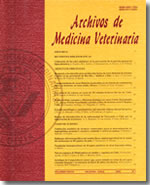Phenotypic correlations among economic important traits in Suffolk Down and Merino Precoz sheep in central Chile
Main Article Content
Abstract
Suffolk Down (S) and Merino Precoz (MP) are the main sheep breeds reared in central and south central area of Chile. In both breeds the main source of income for farmers is weaned lamb sale, therefore traits associated to reproduction, live weight and growth were included in the selection objectives of genetic improvement programs. In dual purpose breeds, fleece weight, and length and diameter of the fiber were also included in genetic programs. The objective of this study was to estimate phenotypic correlations among some economically important traits in meat and dual purpose sheep. The traits studied in S and MP were birth weight (BW) and birth to weaning growth rate (GR). For MP breed, greasy fleece weight (GFW), fiber diameter (FD) and staple length (SL) were also included. Variance components estimation was done by least squared means. Estimated variances for BW in S and MP were: 0.58 kg2 and 0.52 kg2, respectively. Regarding GR, in the same order, estimated variances were 1,150 g2 and 1,208.7 g2. Further, in MP were also estimated the variances for GFW (0.296 kg2), FD (3.31μm2 and SL (293.8 mm2). Estimated phenotypic correlation between BW and GR for S lambs was 0.12 ± 0.05, (P = 0.036). For MP breed the correlation between these traits was -0.05 ± 0.04 (P = 0.14). In MP breed, only phenotypic correlation between GFW and SL was significant. The estimated correlations were: GFW-DF (0.043 ± 0.07), GFW-SL (-0.207 ± 0.10) and DF-SL (0,035 ± 0.10). Among wool and live weight traits, estimated phenotypic correlations were: GFW-BW (0.02 ± 0.07), FD-BW (-0.08 ± 0.10), SL-BW (0.12 ± 0.10), GFW-GR (-0.11 ± 0.07), FD-GR (-0.03 ± 0.10) and SL-GR (0.05 ± 0.10). Neither of this values was statistically different from zero (P > 0.05). It si concluded that there exist a large environmental variability for live weight and growth.

